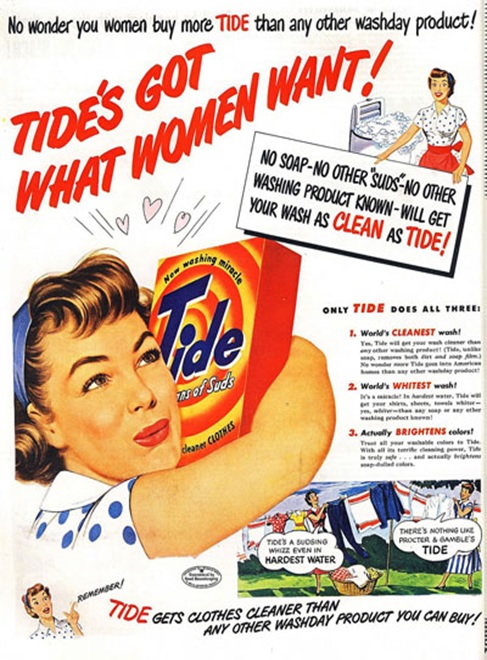Advertising case studies.
Tide Print Advert

Background on the Tide Advert:
- Designed specifically for heavy duty machine cleaning
- Launched in 1946 and it quickly became a brand leader in America
Some textual analysis of the advert:
- Background is white - suggesting purity and the cleanliness of the product
- The woman holding/hugging tide is the centre image emphasising how it is the crucial to her life
- It uses the stereotype that woman are the ones who clean = sexist - the writing is in red associating with woman - red can also be associated with romance.
- The woman is happy which shows to the audience that if they buy this product they will also be happy
- There is a comic print in the bottom right to make the advert more engaging.
WaterAid audio and visual advert

WaterAid - background
The charity wateraid was established in 1981 as a response to the united nations campaign for clean water, sanitation and water hygiene education. It now works with organisations in 37 African, Asian and Central American countries plus the Pacific region . Since 1991 its Patron leader has been Prince Charles.
Some textual analysis of the advert:
- focuses on tap and sun to emphasise how special they are and how much they can impact the people like Claudia
Kiss of the Vampire poster

- woman in the gold dress looks violent is diverting from the stereotypical view from women (normal stereotypical view is that she is scared and dies/gets rescued)
- IT CAME OUT IN 1963
- Proairetic code of the women being bitten by an arm shows that she is going to turn into a vampire which is an example of intertextuality due to the fact that this has happened before
- Binary Oppositions of Humans vs Vampires
- Typical romance narrative with a gothic twist
- setting is a stereotypical vampire film - abandoned stately home - looks like a typical vampire film.
- Use of low key lighting = connotes a feeling of suspense or mystery = hermeneutic code

Background on the Tide Advert:
- Designed specifically for heavy duty machine cleaning
- Launched in 1946 and it quickly became a brand leader in America
Some textual analysis of the advert:
- Background is white - suggesting purity and the cleanliness of the product
- The woman holding/hugging tide is the centre image emphasising how it is the crucial to her life
- It uses the stereotype that woman are the ones who clean = sexist - the writing is in red associating with woman - red can also be associated with romance.
- The woman is happy which shows to the audience that if they buy this product they will also be happy
- There is a comic print in the bottom right to make the advert more engaging.
WaterAid audio and visual advert

WaterAid - background
The charity wateraid was established in 1981 as a response to the united nations campaign for clean water, sanitation and water hygiene education. It now works with organisations in 37 African, Asian and Central American countries plus the Pacific region . Since 1991 its Patron leader has been Prince Charles.
Some textual analysis of the advert:
- focuses on tap and sun to emphasise how special they are and how much they can impact the people like Claudia
- Slow motion shots to emphasise the importance of water
- initial tracking shot symbolises their lack of wealth as it follows Claudia as she collects water
- African people are represented as cheerful, happy and carefree example of positive representation yet also stereotypical
- Binary opposition of rainy, miserable England and colourful, cheerful Africa
- Atypical representation of Africa
- Audiences now desensitised to charity adverts - The Claudia advert represents a resolutely positive ideology to it's target audience
- woman in the gold dress looks violent is diverting from the stereotypical view from women (normal stereotypical view is that she is scared and dies/gets rescued)
- IT CAME OUT IN 1963
- Proairetic code of the women being bitten by an arm shows that she is going to turn into a vampire which is an example of intertextuality due to the fact that this has happened before
- Binary Oppositions of Humans vs Vampires
- Typical romance narrative with a gothic twist
- setting is a stereotypical vampire film - abandoned stately home - looks like a typical vampire film.
- Use of low key lighting = connotes a feeling of suspense or mystery = hermeneutic code
Comments
Post a Comment